In the human body, the skin is one of the most important organs. It performs several functions at once: barrier, excretory, sensitive, thermoregulatory, storage and others. Therefore, parents should carefully monitor the condition of their baby’s skin from early childhood.
Normally, a child’s skin should be clean, smooth, without cracks or inflammation. If there are any changes on it (redness or roughness), parents should immediately pay attention to it. The child’s body signals that something has gone wrong.
If a child has dry skin, it means that the stratum corneum does not contain enough moisture. Its appearance changes - it becomes rough, wrinkled, sometimes even scaly, and loses elasticity. But that's not the worst thing. The danger lies in the fact that microcracks appear in dry skin, through which pathogenic bacteria easily penetrate into deeper layers and become the cause of the development of dermatological diseases.
Why does my baby have dry skin?
Dry skin in a child usually occurs in the first three years of life in the autumn-winter period or early spring. This phenomenon can be observed both on individual parts of the body (arms, legs, face) and on its entire surface. Children's skin is very sensitive to external factors, its protective function is just developing. Therefore, when dry spots or rashes appear on the body, it is important to determine which personal hygiene items can cause irritation to the epidermis, and exclude shampoos, soaps, gels, and washing powders to which the baby may be allergic. If your child has dry skin, you should choose only hypoallergenic hygiene and laundry products, preferably without a strong odor and bright color.
You should not bathe your baby in hot water, as it tends to dry the skin; the optimal temperature for this procedure is 37°C.
Sudden changes in temperature can also cause dry skin in a child. Severe frost and cold winds often cause irritation and redness on the face and hands. Therefore, before going outside, the baby needs to lubricate exposed areas of the body with a special cream.
Heating systems operating in winter dry out the air in apartments, so it is recommended to use special humidifiers during this period.
Dry skin in a child can be an allergic reaction of the body, so you should pay attention to food. Among them may be those that provoke allergies, in particular citrus fruits and chocolate.
Dry skin on a child's feet
Quite often, children have dry skin on their feet. Especially in the summer, it loses moisture to such an extent that it begins to crack and hurt. In this case, it is better to wear open shoes with maximum air access. To avoid dust and dirt getting into the cracks, you need to wear socks. Before going to bed, be sure to wash your baby’s feet with baby soap, wipe them dry and lubricate them with massaging movements with a special softening fortified cream.
Dry skin on a child's feet is highly susceptible to infections, which can lead to complications. The familiar heat rash, diaper dermatitis, and diaper rash spread quickly if not properly cared for, and a pustular rash can even form. To avoid complications, it is necessary to show the child to the doctor as soon as possible and begin treatment.
Treatment of dry skin in children
The epidermis in young children is not yet able to retain moisture in sufficient quantities, so it has to be replenished from the outside. The choice of moisturizer must be taken seriously, since the skin reacts sharply to external irritants. If the child has very dry skin, choose a product together with the pediatrician. Most often, in such cases, doctors recommend external preparations containing urea, in particular Excipial M lotion, as well as an additional course of vitamin A for a period of two months. It is better absorbed if you drop it on a small piece of black bread before eating. In some cases, if the baby’s skin is inflamed, vitamin E, calcium supplements, and fish oil are prescribed. The dose of medication is determined by the doctor.
It is better to bathe your child without foaming detergents at all. Herbal baths are very effective in such cases. You need to mix rose petals and chamomile flowers in equal proportions, pour boiling water over it and let it brew for 15-20 minutes. After this, strain and add to water. The procedure should last at least 10 minutes. A bath with flax oil is also effective (1 tablespoon will be enough).
After bathing, you can give your baby a massage, treating the skin with a cream containing vitamin A.
Dry skin of a child as a sign of the onset of the disease
Sometimes dry skin can indicate the onset of a disease. Therefore, if redness or irritation occurs, parents need to consult a doctor to make an accurate diagnosis, establish the cause and begin treatment. Dry skin in a child, mainly under the age of 1 year, often occurs with atopic dermatitis. Severely itchy, reddened areas are localized on the face, without affecting the nasolabial triangle.
Peeling and scaly formations on the elbows, knees, and cheeks may be signs of ichthyosis, a genetic disease in which the process of keratinization of cells in the body is disrupted.
If a child’s skin is very dry and peeling, most likely it is hypovitaminosis A and PP; treatment in the form of taking the necessary vitamins eliminates unpleasant symptoms.
It should be taken into account that dry skin can be caused by dehydration due to dyspeptic disorders (vomiting, diarrhea) and heavy sweating.
Dry spots on baby's skin
Dry spots on children's bodies often appear, and there is nothing unusual or scary about this, because she is very sensitive. But parents should be concerned if they do not go away for a long time. Firstly, the cause of such spots may be physiological, since in young children the fat glands are not yet fully functioning. Secondly, the condition of the skin is influenced by environmental factors (temperature and water hardness, air humidity, food, soap). At first, to soften the affected areas, you can use a product purchased at the pharmacy, for example, Panthenol. But if dry spots on the child’s skin do not disappear, you should consult a doctor, as they can be symptoms of serious diseases such as atopic dermatitis, eczema, and psoriasis.
Skin ailments are usually difficult to deal with, but a correct diagnosis made in time makes the task easier. If there are signs of a particular skin disease at an early age, it is very important to immediately take action and prevent its progression. Without proper treatment in a medical facility, it can become chronic.
Video from YouTube on the topic of the article:
You can find out about the development of problems in the human body if you pay attention to the fact that he has dry skin on his hands and feet - the reasons can be different. When the palms or feet begin to dry, or the skin on the legs and arms of an adult or child begins to peel, this is not only a lack of hydration. Dryness often indicates the presence of chronic diseases.
Why does skin dry out?
Ancient healers determined a person's health by the condition of his skin. Performing protective functions, the skin participates in water-salt metabolism and thermoregulation. Any problems with this organ indicate an incipient or progressive pathology in the body. The causes of dry skin can be both internal and external. Before stocking up on moisturizing creams, you should understand what external factor dries out the epidermis and eliminate it:
- unbalanced diet;
- bad habits;
- hair removal, depilation;
- frequent peeling sessions, dermabrasion;
- low-quality cosmetics;
- wearing synthetic underwear;
- age-related changes;
- improper care;
- low indoor humidity;
- prolonged exposure to heat or cold;
- sudden changes in temperature.
Causes of dry skin on feet
If vitamin deficiency is excluded, then drying out of the epidermis of the lower extremities indicates uneven blood circulation. Blood flow can be disrupted by wearing tight shoes or small tights. This fact causes not only dry skin, but also the formation of varicose veins. High socks and too-tight leggings are harmful; wearing them regularly will cause dry skin on your legs. Another factor that dries out the epidermis of the lower extremities is the use of cosmetics that contain a lot of alkalis.
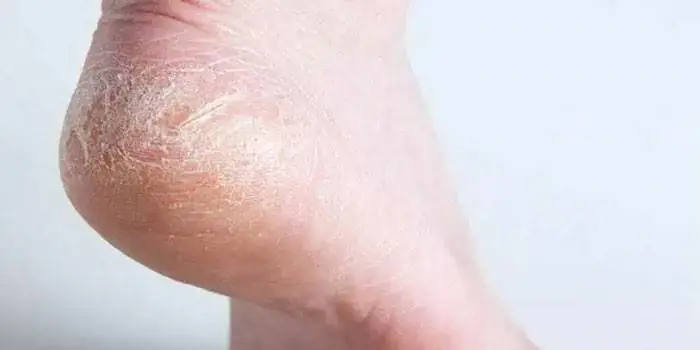
Many women are interested in the question, especially in winter, why the skin on their legs is dry and flaky. The answer lies on the surface - she is dehydrated. It is difficult for the body to retain natural moisture in winter; as a result, the skin on the legs peels, it becomes white, covered with small scales, and in general, it looks unaesthetic. The situation can be corrected by proper drinking regimen. Not sweet coffee or tea, but clean drinking water per day, no less than 1.5 liters.
If you have not walked barefoot on the ground or on hard surfaces, but your feet are very dry, this may indicate that they have a fungal infection. Diagnosing an infectious disease is not difficult: thickening of the nails is visible, the skin of the fingers takes on an unnatural red tint, peels, and itches. If all of the listed symptoms on the foot are present, you should go to a dermatologist. The specialist will order a test that will identify the type of fungus, after which you need to treat the infection with the appropriate ointment.
Many people have a very sensitive epidermis, so the skin on their legs below the knees peels due to the aggressive effects of cold, sun, wind, water or air. The solution to the problem can be greasy care creams or cosmetics with high UV protection. The cause of dryness can be the body's reaction to any food irritant. It is necessary to identify the product that causes the allergic reaction and remove it from the diet.
Peeling of the epidermis below the knees and on the ankles can occur for natural reasons when the body's processes slow down due to aging. After 50 years of age, the skin becomes thin as it loses moisture. This condition is caused by age-related changes in collagen fibers, which are the building blocks of the epidermis. Eating foods rich in collagen will help normalize fat and lipid metabolism: kelp, rabbit meat, turkey, fatty salmon fish, leafy greens.
Often the cause of the problem lies in lifestyle. For example, a man or woman adheres to a strict diet, limiting the intake of necessary substances into the body. As a result, the skin on the feet and toes cracks. Effective treatment of dry epidermis - a full course of vitamin therapy. Sometimes this symptom indicates a dysfunction of the thyroid gland, so it would not be superfluous to be examined by an endocrinologist.
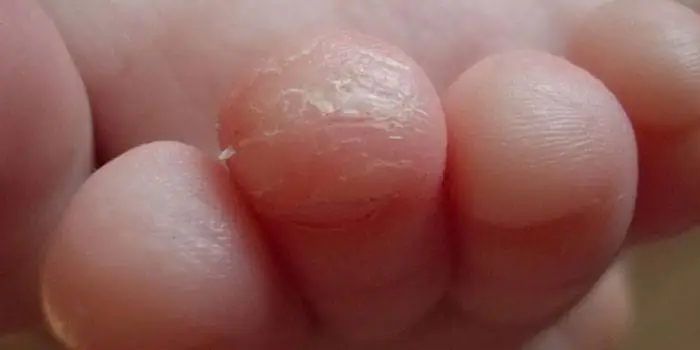
This problem usually occurs after improper shaving. The following will help correct the situation: a sharp blade, special depilatory creams and moisturizing the epidermis. You can eliminate dry skin on the lower legs using olive, flaxseed or coconut oil, which must be rubbed in daily after showering or shaving. Increased dryness will go away if you make a nourishing mask several times a week, which contains: baby cream, 3 drops of glycerin, 1 drop each of vitamin E and A (oil solution).
Causes of dry hand skin
Wrinkling, peeling, permanent condition of the skin of the upper extremities - many people are familiar with this situation. These symptoms are a signal from the body that it is necessary to start taking care of your hands. Insufficient care, vitamin deficiency and stress have a bad effect on the condition of the epidermis. However, the causes of dry hand skin are not only external. This condition may be due to other factors:
- Diseases of the gastrointestinal tract. With a lack of vitamins and microelements, the functioning of the digestive system is disrupted, which immediately affects the condition of the epidermis.
- Diabetes. Increased sugar provokes dry skin.
- Iron-deficiency anemia. The disease causes dry and itchy skin, which begins to crack and hurt.
- Fungal infections. If your feet are affected by a fungus, then it is more likely that the peeling of your hands is also caused by it.
- Allergy. Caused by anything from household chemicals to wearing rings. A dermatologist will identify the allergen after tests.
Why does the skin on my palms peel?
Peeling of the palms is much less common, but the sight is unsightly and unpleasant. The factors that lead hands to such a state are varied, and the method of solving the problem depends on the reason that caused it. If the skin on your palms is dry, you should definitely contact a dermatologist, because such symptoms appear during exacerbation of eczema, dermatitis or psoriasis. Self-medication with such a diagnosis is unacceptable. There are many diseases, signs of which are peeling and bursting of the epidermis on the palms:
- lupus erythematosus;
- staphylococcal infections;
- lichen planus;
- syphilis;
- fungal infections;
- scabies;
- hyperkeratosis, parakeratosis.
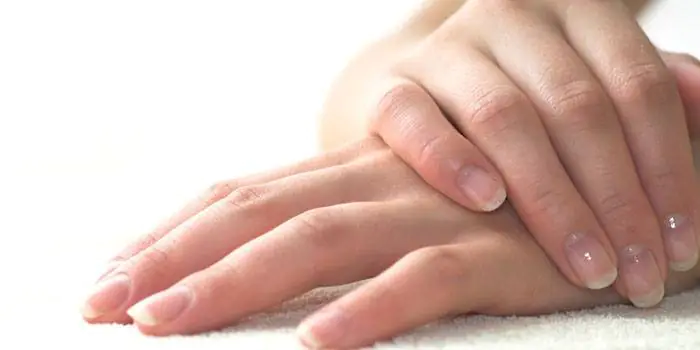
On fingers
With frequent contact with water, a person’s hand skin becomes very dry, because water dries out the epidermis and washes away the protective layer. This problem can be corrected if you regularly take baths with such softening ingredients as a decoction of oak bark, nettle, chamomile, St. John's wort, linden, and sage. Often dry skin on the fingers occurs due to weakened immunity or vitamin deficiency in spring and autumn. In this case, nutritional adjustments are needed. If you have congenital dryness or a genetic predisposition, your fingers need softening throughout the year.
Dry skin between fingers
When peeling of the epidermis between the fingers occurs, many reasons can be suspected. Most are due to improper hand care or reactions to detergents. Other causes of dryness between the fingers are a fungal infection or vitamin deficiency. What to do to avoid the problem:
- After washing your hands, the area between the fingers should be thoroughly dried;
- When washing dishes or doing laundry, use gloves and then moisturize;
- choose the right creams (ointments) for your hands and regularly care for them;
- In cold weather, do not be without warm gloves or mittens.
Dryness and redness of the skin of the hands
Why does the skin on my hands dry out? Women are especially concerned about this combination of pathologies such as dryness and redness. If the skin bursts at the same time, then most likely this is a consequence of lack of care. To prevent dryness and redness of the skin of your hands, as well as dermatitis, blisters and peeling, which can occur due to poor hygiene, you need to constantly lubricate them. Folk recipes provide excellent hydration and nutrition effects. Our ancestors also advised:
- apply cream, sour cream or make milk compresses after each hand wash;
- use unrefined vegetable oil as a compress at night under gloves.
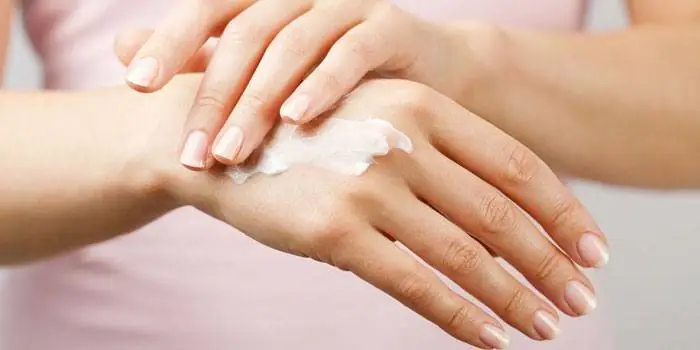
Dry skin in a child
In children, the epidermis dries out for many reasons. Basically, cracks on the body are provoked by low activity of the sebaceous glands, which arise due to increased water hardness. Dry skin in a child is caused by diseases of the gastrointestinal tract, poor nutrition of the mother during lactation or pregnancy, and early refusal of breastfeeding. As a rule, it is not worth treating the sensitive epidermis of a one-year-old child. Over time, it returns to normal on its own.
Immediately after birth, the baby’s epidermis is covered with vernix lubrication, which first helped pass the birth canal and then adapted the child to the air environment. When the substance dries, rough skin appears on the baby, which immediately reflects irritation, dermatitis, and allergic manifestations. The situation is aggravated by unfiltered bathing water, lack of air baths, infrequent changes of linen, and poor mother’s diet. In order for the upper layer of the child’s epidermis to adapt faster, the following measures should be taken:
- improve nutrition;
- remove all irritating factors;
- choose only hypoallergenic products for bathing;
- increase the humidity in the children's room to 75-80%;
- lower the room temperature to 19-21 degrees.

Every mother really wants her baby to look like in the commercial - plump, smiling, with soft velvety skin that you just want to rub your cheek against. However, in practice, babies do not always look so appetizing, and such a problem as dry skin in a child gives his parents a lot of reasons for worry. Authoritative children's doctor Evgeniy Komarovsky tells what reasons can cause dry skin in a baby, and what parents should do.
Features of children's skin
A baby's skin is significantly different from the skin of its parents. She is more vulnerable, gentle. Sweat glands are not sufficiently developed in the first year of life, and therefore the baby has to give off excess heat through pulmonary breathing. If at the same time the baby has to breathe too dry air, or he lives in a room where, thanks to the efforts of his mother and grandmother, it is hot all the time, then the load on the immature sweat glands increases and the skin deteriorates.
The stratum corneum (the uppermost layer) of children's skin is well supplied with blood, so any scratches on a baby heal faster than on an adult. However, the stratum corneum, which is thin and loosely connected to other skin layers, creates favorable conditions for irritation and injury.
Initially, dry skin in babies practically never occurs due to the saturation of lipids - an innate feature of all toddlers. But these fats perfectly dissolve most of the chemicals that are contained in washing powder, soap, and urine, and therefore inflammation of the skin in children is common. Dry skin can also become due to health problems.

Causes of dryness
The most common cause of dryness, in which the skin becomes somewhat rough to the touch, is contact dermatitis, says Evgeny Komarovsky. In this case, the skin is damaged due to contact with chemicals contained in washing powder or in household chemicals that the mother uses for cleaning. Contact dermatitis often occurs in response to chlorinated tap water used to bathe and wash a child.
If the skin on the lips of a child dries out, causing the lips to crack, there may be several reasons:
- dry air in the room;
- vitamin A deficiency;
- side effects of certain medications;
- allergic reaction;
- herpes virus.
If a child has dry skin on the cheeks or nose, as a result of which it often peels off, we can talk about a lack of vitamins E, A, as well as allergies.
In 90% of cases, dry skin of a toddler is caused by parents violating the rules of a favorable microclimate - the house is hot and dry.


Treatment
Contact dermatitis, in which the lesions are minor and appear as small dry patches, is eliminated by the use of topical moisturizers, such as baby creams containing aloe. The most effective local medicine, according to Evgeniy Komarovsky, is Bepanten ointment or cream. For more extensive lesions, the microclimate in the room where the child is located should be changed.
Bathing water must be boiled or filtered, bedding and baby clothes must be washed exclusively with a special baby powder, which is marked “Hypoallergenic” on the packaging. After washing, things should be additionally rinsed not with ordinary tap water, but with pre-boiled water, since during the boiling process the liquid gets rid of chlorine.
In the next video, Dr. Komarovsky talks about skin problems with allergic dermatitis.
If the skin is dry due to an allergic reaction, the doctor may prescribe antihistamines; it will be necessary to find the true cause of the body’s inadequate reaction. This is the task of an allergist, and parents need to make sure that the child does not have contact with the most common allergens - animal hair, dust, pollen, chemicals and chlorine. It is important to ensure that the baby does not sweat, so you should not overwrap him or overheat the room.
Chapped lips and rough skin on the cheeks and nose are treated according to the reason why they are cracked or dry. Oil solutions of vitamins A and E are almost always prescribed. Sea buckthorn oil is recommended for topical use; for lips, you can use hygienic moisturizing lipstick with aloe. The child should drink more fluids. For cracking of the skin of the feet, heels and toes, local antifungal therapy and the same sea buckthorn oil can be prescribed.
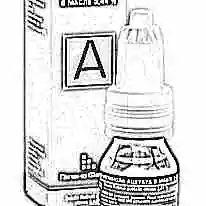
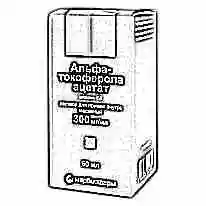
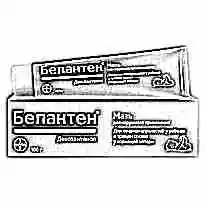
Advice from Dr. Komarovsky
Many problems with dry skin can be solved simply by creating normal conditions for the child. It doesn’t really matter how old the offspring is - 1 year or 15, he should breathe cool and sufficiently humidified air. If you maintain the temperature in the apartment at 18-20 degrees, and the relative air humidity at 50-70%, then ointments and creams may not be needed at all, because with such environmental parameters the skin rarely dries out.
For children who have already had this happen, dermatologists advise (and Komarovsky completely agrees with them!) not to use hot baths for bathing, it is better to limit yourself to warm water, and less often to use detergents - gels, foams and shampoos. It is enough to use baby soap once a week. Bathing time for such babies should not exceed 10-15 minutes, and the door to the bathtub should be closed tightly so as not to reduce air humidity. After bathing a child with dry skin, you should not dry it with a towel, but gently pat it dry.
When choosing a moisturizer, parents should give preference to options with added oils. You should not use gels and shampoos with a strong odor, rich perfume additives and dyes. From a huge range of soaps, it is better to choose liquid baby soap.
Parents of a child with dry skin should make sure that the toddler, crawling or playing, does not rub against carpets, so that clothes do not rub his “problem” areas. Particular attention should be paid to the choice of a disposable diaper; it is best to give preference to manufacturers who add a layer impregnated with aloe balm to the diaper.
A child with a tendency to dry skin should not stay in the open sun for long periods of time. If there is a vacation by the sea, the mother must make sure that the child is smeared with moisturizers with UV protection, and in the evening, after a shower, with baby cream.



